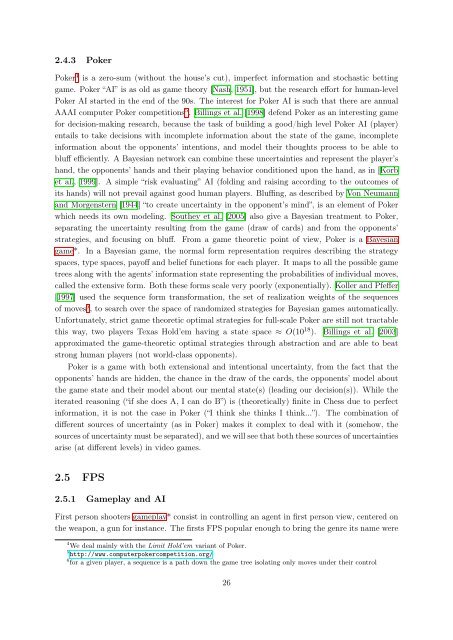Bayesian Programming and Learning for Multi-Player Video Games ...
Bayesian Programming and Learning for Multi-Player Video Games ...
Bayesian Programming and Learning for Multi-Player Video Games ...
Create successful ePaper yourself
Turn your PDF publications into a flip-book with our unique Google optimized e-Paper software.
2.4.3 Poker<br />
Poker 4 is a zero-sum (without the house’s cut), imperfect in<strong>for</strong>mation <strong>and</strong> stochastic betting<br />
game. Poker “AI” is as old as game theory [Nash, 1951], but the research ef<strong>for</strong>t <strong>for</strong> human-level<br />
Poker AI started in the end of the 90s. The interest <strong>for</strong> Poker AI is such that there are annual<br />
AAAI computer Poker competitions 5 . Billings et al. [1998] defend Poker as an interesting game<br />
<strong>for</strong> decision-making research, because the task of building a good/high level Poker AI (player)<br />
entails to take decisions with incomplete in<strong>for</strong>mation about the state of the game, incomplete<br />
in<strong>for</strong>mation about the opponents’ intentions, <strong>and</strong> model their thoughts process to be able to<br />
bluff efficiently. A <strong>Bayesian</strong> network can combine these uncertainties <strong>and</strong> represent the player’s<br />
h<strong>and</strong>, the opponents’ h<strong>and</strong>s <strong>and</strong> their playing behavior conditioned upon the h<strong>and</strong>, as in [Korb<br />
et al., 1999]. A simple “risk evaluating” AI (folding <strong>and</strong> raising according to the outcomes of<br />
its h<strong>and</strong>s) will not prevail against good human players. Bluffing, as described by Von Neumann<br />
<strong>and</strong> Morgenstern [1944] “to create uncertainty in the opponent’s mind”, is an element of Poker<br />
which needs its own modeling. Southey et al. [2005] also give a <strong>Bayesian</strong> treatment to Poker,<br />
separating the uncertainty resulting from the game (draw of cards) <strong>and</strong> from the opponents’<br />
strategies, <strong>and</strong> focusing on bluff. From a game theoretic point of view, Poker is a <strong>Bayesian</strong><br />
game*. In a <strong>Bayesian</strong> game, the normal <strong>for</strong>m representation requires describing the strategy<br />
spaces, type spaces, payoff <strong>and</strong> belief functions <strong>for</strong> each player. It maps to all the possible game<br />
trees along with the agents’ in<strong>for</strong>mation state representing the probabilities of individual moves,<br />
called the extensive <strong>for</strong>m. Both these <strong>for</strong>ms scale very poorly (exponentially). Koller <strong>and</strong> Pfeffer<br />
[1997] used the sequence <strong>for</strong>m trans<strong>for</strong>mation, the set of realization weights of the sequences<br />
of moves 6 , to search over the space of r<strong>and</strong>omized strategies <strong>for</strong> <strong>Bayesian</strong> games automatically.<br />
Un<strong>for</strong>tunately, strict game theoretic optimal strategies <strong>for</strong> full-scale Poker are still not tractable<br />
this way, two players Texas Hold’em having a state space ≈ O(10 18 ). Billings et al. [2003]<br />
approximated the game-theoretic optimal strategies through abstraction <strong>and</strong> are able to beat<br />
strong human players (not world-class opponents).<br />
Poker is a game with both extensional <strong>and</strong> intentional uncertainty, from the fact that the<br />
opponents’ h<strong>and</strong>s are hidden, the chance in the draw of the cards, the opponents’ model about<br />
the game state <strong>and</strong> their model about our mental state(s) (leading our decision(s)). While the<br />
iterated reasoning (“if she does A, I can do B”) is (theoretically) finite in Chess due to perfect<br />
in<strong>for</strong>mation, it is not the case in Poker (“I think she thinks I think...”). The combination of<br />
different sources of uncertainty (as in Poker) makes it complex to deal with it (somehow, the<br />
sources of uncertainty must be separated), <strong>and</strong> we will see that both these sources of uncertainties<br />
arise (at different levels) in video games.<br />
2.5 FPS<br />
2.5.1 Gameplay <strong>and</strong> AI<br />
First person shooters gameplay* consist in controlling an agent in first person view, centered on<br />
the weapon, a gun <strong>for</strong> instance. The firsts FPS popular enough to bring the genre its name were<br />
4 We deal mainly with the Limit Hold’em variant of Poker.<br />
5 http://www.computerpokercompetition.org/<br />
6 <strong>for</strong> a given player, a sequence is a path down the game tree isolating only moves under their control<br />
26


